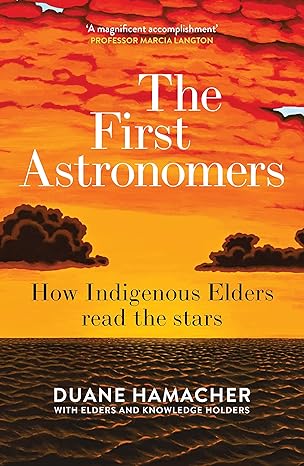My next review is of First Astronomers: How Indigenous Elders read the stars by Duane Hamacher. It is fair to say that Western astronomers, and other Western scientists have not treated Indigenous populations, and their knowledge, with a great deal of respect. Even now astronomers are in dispute with Indigenous populations in Hawaii over the siting of telescopes. In this book Hamacher tries to redress this imbalance and in my view does a good job of treating his interviewees, and their knowledge, with respect.
Western astronomers are not alien to interacting with people outside their professional group as part of their research most notably using historical data, like Chinese records of supernova but also amateur observers play an important in modern astronomy – particularly in the observation of comets and the like and other transient phenomena accessible using modest equipment.
The book starts with a prologue describing the background to the book and introducing a number of the Indigenous people who contributed, in the longer frontspiece they are listed as co-authors. They are largely from Australia but there are references to New Zealand, North American Native Americans, Artic peoples, South American and Africa groups.
Hamacher is an astronomer by profession and this has a bearing on this interviews with Indigenous Elders. In the past anthropologists have talked to Elders about their star knowledge and a lack of astronomical knowledge has led to mis-interpretation. I was intrigued to learn that in Western mythology the star name “Antares” is derived from the greek “anti Mars” – since Mars and Antares, in the same part of the sky and with a reddish hue are often confused!
The book is then divided thematically into chapters relating to different sorts of stars (including the moon). These are The Nearest Star (the sun), The Moon, Wandering Stars (planets), Twinkling Stars, Seasonal Stars, Variable Stars, Cataclysmic Stars (supernova and the like), Navigational Stars and Falling Stars (meteors and craters).
The big difference a Western reader will see is that Indigenous knowledge is transmitted via oral traditions, incorporating song and dance. Oral traditions are about creating a story around some star locations that provide useful information like where and when to hunt a particular animal or plant a particular crop, or where you are and how to get to where you want to be . The story linked to the stars allows it to be transmitted to the next generation without error. They are mnemonics rather than an attempt to describe a factual truth. This is obvious in Indigenous oral traditions which are still alive but I suspect it would have been the case for the oral traditions of Western Europe which give us our modern constellations.
Oral traditions can be very powerful, there is a group of craters in Australia (the Henbury Craters) which were created by a meteor impact around 4200 years ago – Aboriginal oral traditions have held this knowledge of their creation across that period of time.
Indigenous constellations can overlap and change through the seasons, they also incorporate dark space – particularly in the Milky Way. These constellations are locally determined to fit with local conditions, and land features used as landmarks.
As well as maritime navigation where the stars are used directly for finding direction, the stars are also used as a navigational aid for terrestrial travel – the routes are learnt in the dark of the winter using the stars as a map of the ground (picking stars which approximate the locations on the ground). These “songlines” are reflected in some modern day highways in Australia.
What comes through from the book is that Indigenous astronomers were very astute observers of the sky, noting phenomena including the varying twinkle of stars (including colour and intensity variations), the 8 year period of Venus returning to the same location in the sky, variable stars, sunspots and their 11 year cycle, the sounds associated with aurora and so forth. Some of these phenomena were not widely recognised by astronomers in the West until into the 19th century. In addition they had a clear understanding of many phenomena: that the moon reflected the light of the sun, that the earth was a sphere, that craters were the result of rocks falling from the sky.
Unsurprisingly, I was constantly comparing with Western astronomy. The great divergence was sometime around the end of the 16th century when Western astronomers started making detailed written records of the locations of stars and planets and using mathematics to understand them, and then moved on to the use of telescopes. I can’t help feeling the Indigenous people were held back by a lack of writing.
What comes through at the end of the book is that in the Indigenous communities have a long history of passionate and astute astronomers, dedicated to their role, and increasingly they are taking part and excelling in Western astronomy and astrophysics.












